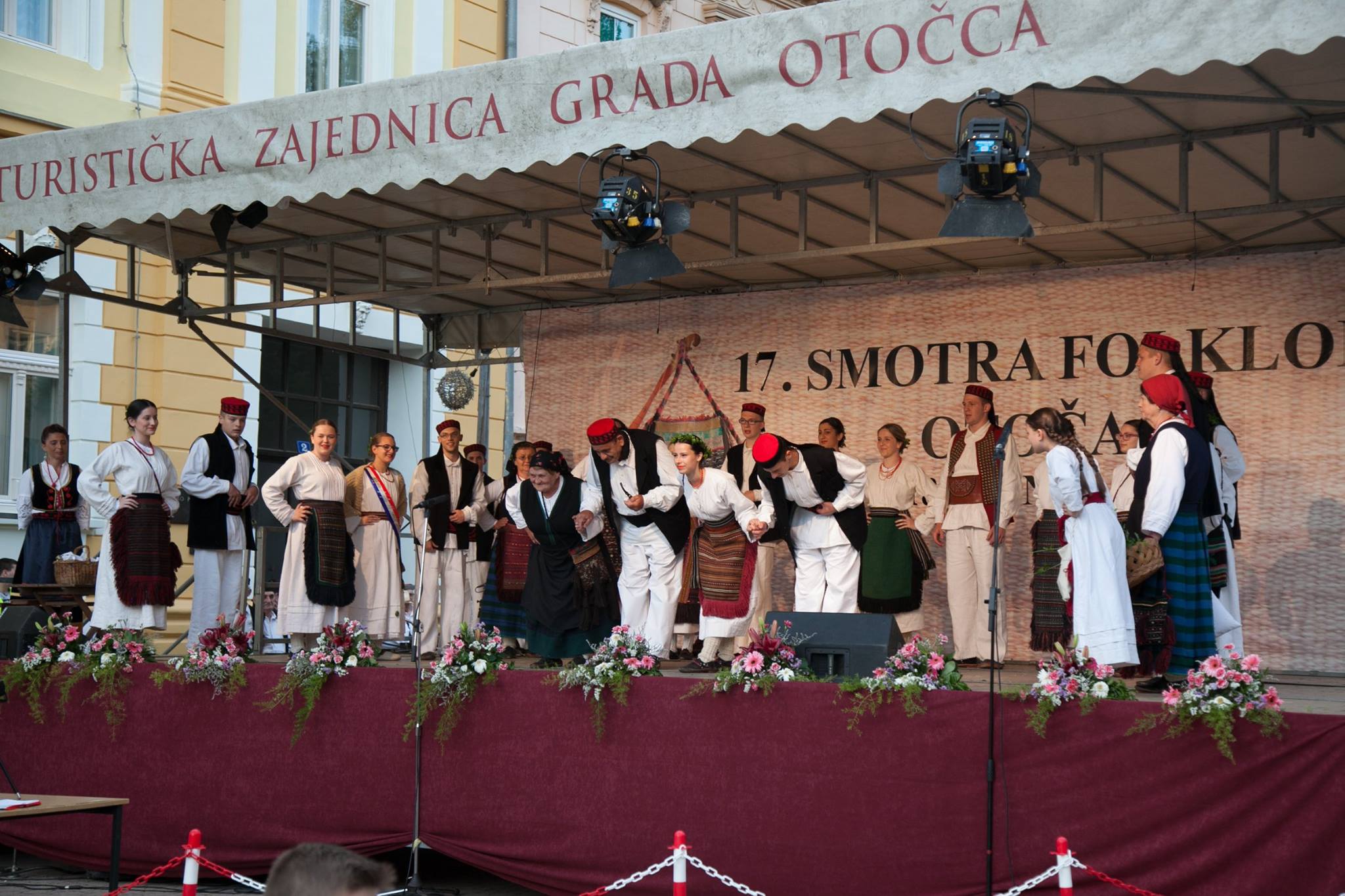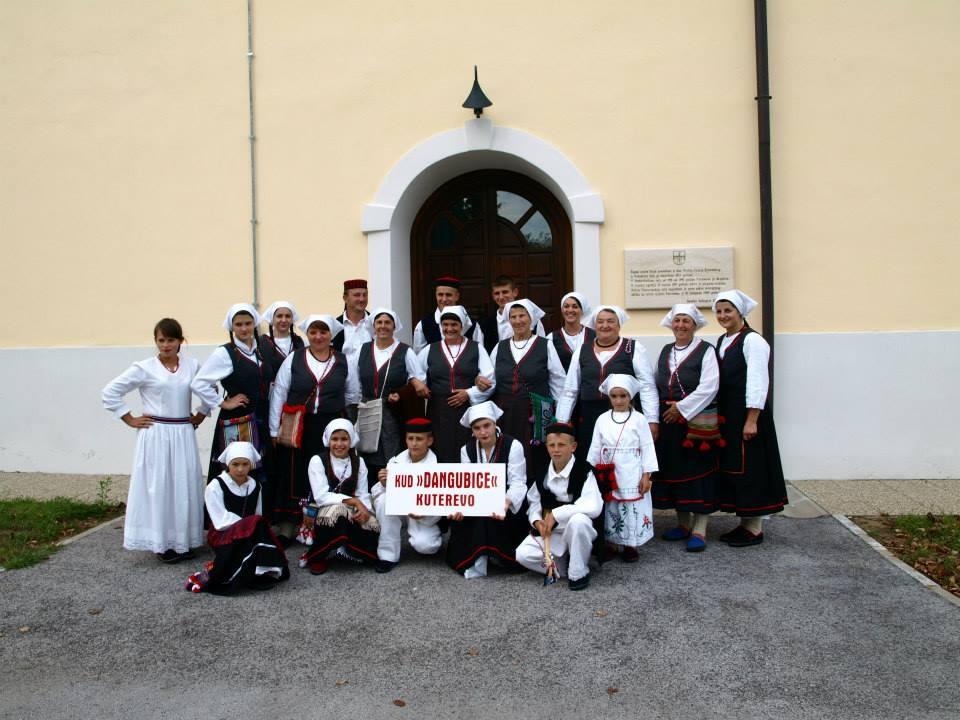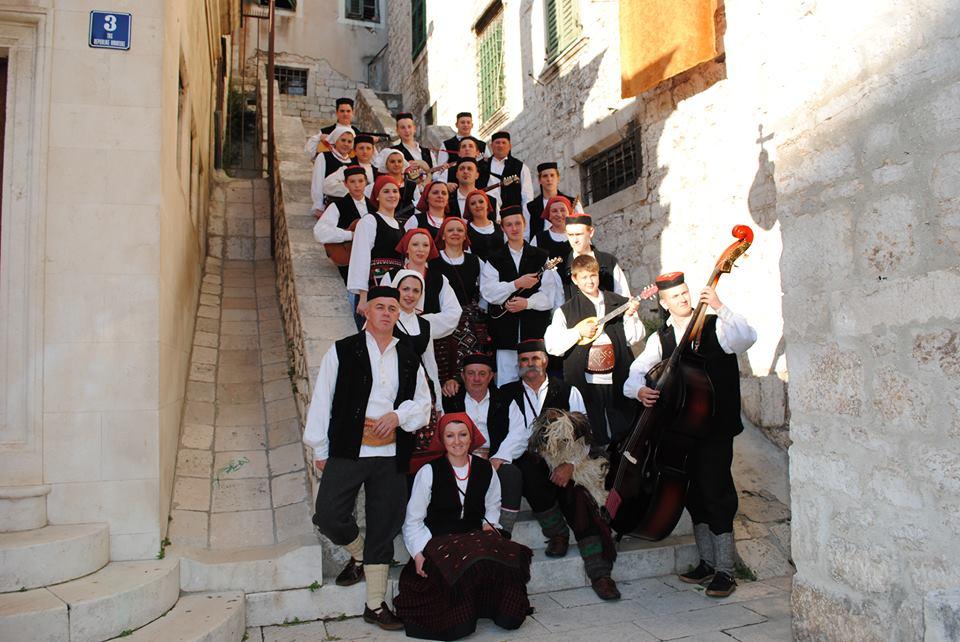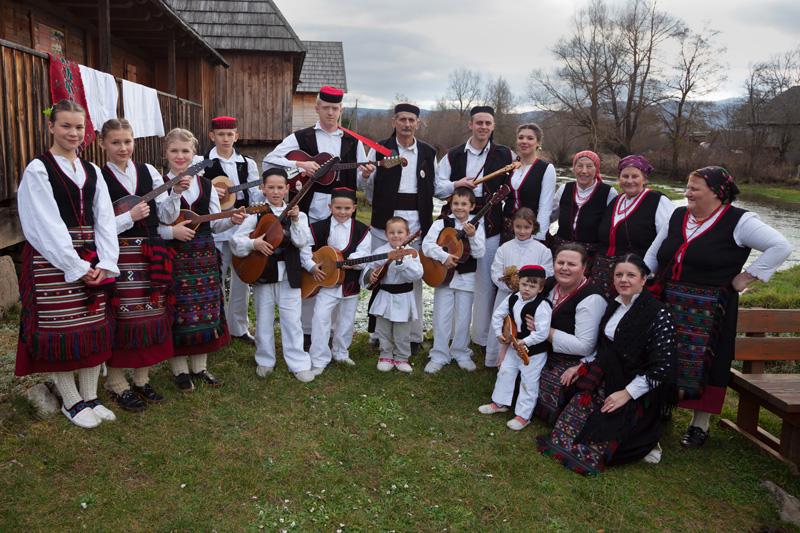Ličko Lešće lies on the left bank of the river Gacka along the Otočac-Gospić road. There is also a railroad passing through the village. Lešće is located in the Gacka valley between the slopes of Kapela and Velebit mountains, surrounded by a mountain range on three sides.Ličko Lešće lies on the left bank of the river Gacka along the Otočac-Gospić road. There is also a railroad passing through the village. Lešće is located in the Gacka valley between the slopes of Kapela and Velebit mountains, surrounded by a mountain range on three sides.
The evidence of human habitation in this area can be traced back to the Middle Stone Age with the earliest finds, as old as 10000 - 4000 B.C. discovered in the Pećine cave site. Numerous charred remains of animal bones and bones with clear traces of stone tools indicate the presence of a Middle Stone Age material culture. In the Late Bronze Age, Lešće was inhabited by Iapodes tribes as confirmed by ceramic fragments found in the Pećine cave. There is also evidence of Roman and ancient Croatian settlers. From the ancient Roman period there are two limestone bases with inscribed texts in honour of the Roman emperors Augustus and Trajan. In the Pećine cave there is a clean and clear stream called Kostelka (Tepli potok) and a number of smaller streams suitable for fishing.
In the village centre there is a Baroque church devoted to St. Mary of the Rosary (popularly known as St. Rosary) originally built in 1700 and rebuilt in 1786. The church has Rococo altars, pulpit, baptismal font and well-preserved liturgical vessels. There is also a small church dating back to 1721, the St. Francis, with walls built from stones of the ruined ancient Roman Arupium with fragments of Latin texts. With the arrival of the Croatian settlers Ličko Lešće embraced a new culture and new customs. Cultural life was vibrant among the population. However, no written records are available to tells us about the life of the villagers and their customs of song, music and dance.
The first organized cultural group emerged in 1928 as the peasant culture association "Seljačka sloga" (Peasant Unity) Ličko Lešće.
A tamburitza ensemble called "Javor" (Maple) was set up. The initiator of the group was Delko Bogdanić, the son of Ilija Bogdanić, one of Lika’s biggest entrepreneurs. The Bogdanić family paid for all the instruments intended for the group/ensemble. Taught by Delko Bogdanić himself, the young and talented tamburitza players, all of them working in a sawmill in Lešće owned by the Bogdanić family, soon developed into a very good vocal tamburitza ensemble. Among them: Frane Marić (Đukan), Mate Vašarević (Mrka, Golubica, singer), Mate Vašarević (Šajan), Ivan Marić (Starešina), Tomo Orešković (Tomac), Dragan Ostović (Babić), Stjepan Ostović, Dragan’s brother, Marko Babić (Markus), Frane Kovačić (Dancik), Nikola Dujmović (Knez), Joso Ladišić (Šnjapar), and Stjepan Orešković (Stipurina, singer).The ensemble had its first performances in Ličko Lešće, Sinac and other villages in the Sinac municipality, and later performed in Otočac, Perušić, Gospić and Senj municipalities. “Javor” also participated in the Zagreb Folk Festival with one of the ensemble members attracting special attention both with his singing skills and his rugged highlander physique – Stjepan Orešković (Stipurina). A photo of this hero from Ličko Lešće has for many years appeared on the cover of the Croatian Cultural Heritage, a publication issued in Zagreb. The name written under the photo said Mane from Popina, a false name used to conceal the identity of Stjepan Orešković from Ličko Lešće during the dictatorship of King Alexander.In 1936, a Community Centre was set up in Vrilo, providing the two culture groups with better conditions for practice. After a local shop owner, Perica Pleša, who built the building for his shop (today housing a post office) had gone bankrupt a few year later, the building was put up for auction and bought by Seljačka Sloga as a venue for cultural events in Lešće. Javor continued in existence until the Second World War. As almost all ensemble members were employed with Ilija Bodganić, his son Delko was able to take them off work and pay them their daily allowances for the interests of the ensemble, thus promoting the culture of the village of Lešće in other parts of Croatia. The 1930s were a period of national awakening in Croatia, a movement lead by Vlatko Maček which resulting in the Cvetković-Maček Agreement and the creation of the Banate of Croatia.After the Second World War, when the tamburitza ensemble and all other forms of cultural activity came to a standstill, teachers Milan and Mandica Sabljak revived the cultural life in the village by forming youth folk and drama groups. Rehearsals were held in the school next to the church. They were soon joined by tamburitza players Franjo Marić (Đukan), Ivan Marić (Starešina), Tomo Orešković (Tomac), Stjepan Kolak (Žiža), Dane Kovačić (Trapan), Dragan Ostović and others. Collective folk dance Kolo, singing with tamburitza accompaniment and male a cappella singing were rehearsed in preparation for the first Folk Festival in Zagreb in 1947. Stjepan Kolak (Kekljin) was then in charge of the culture group.Among the outstanding members of the male singing group were: Franjo Orešković (Stipurina), Stjepan Orešković (Stipurina), Dane Kovačić (Trapan), Jure Marković (Bracan), Milan Jakšić (Jovan), Ivan Jakšić. At the Folk Festival in Zagreb they performed the song "Oj Livado zelena bujado" (Oh Meadow, Green Ferns), and Dane Kovačić (Trapan) had a solo performance with the song "Čuvam ovce i sjedim u ladu i studiram za koga da me dadu" (I Tend to My Sheep, Sitting in the Shade, Musing about Whom to Marry). The folk group performed the collective folk dance Ličko Kolo and the tamburitza ensemble played the song "Junak sam iz Like ja" (I’m a Hero from Lika). The prominent members of the folk group included: Manda Kolak (Rođina), Francika Kolak, Kata Kolak, Mandica Orešković, Luca Orešković. Parallel to the formation of peasant cooperatives in Yugoslavia, community centres began to be built in villages throughout the country. With the construction of a Community Centre in Ličko Lešće in 1949, even better conditions were created for further development of the already vivid cultural life within the village.
When the teacher Milan Sabljak left Lešće to move to Zagreb, a great vacuum was created in the cultural life of the village, however, thanks to a group of young enthusiasts, among them Dane Orešković (Tomac), Tomo Orešković (Tomac), Milan Kolak (Nanika), Ivan Marić (Miloš) and others, a dance group met each Sunday in the Community Centre in Ličko Lešće. Though not a formally organized group, they worked on their own initiative until arrival of Stevica Uzelac as school headmaster and Mandica Šerić as teacher of music and traditional Lika dance. Under the guidance of Mandica Šerić, school children from Ličko Lešće took part in a festival (Slet) in Otočac which was taking place on a football pitch. The students of the elementary school in Ličko Lešće performed a Kolo dance "Ej mati, mati" (My Mother) in the Open University Community Centre.In the early 1960s, Željko Pavelić (Buban), a teacher from Otočac, moved to Lešće. He immediately started teaching children how to play tamburitza and founded a large student tamburizta ensemble. This ensemble yielded a number of important tamburitza players who diligently practiced the tamburizta until the foundation of the Arts and Culture Society (KUD) “Ružica Brkljačić”. There was also a drama group under the guidance of Stevica Uzelac and Mandica Šerić as well as a folk and tamburitza groups. The drama group had many notable performances with the play "Klupko" (Hank) by Pero Budak accompanied with folk and tamburitza performances. Notable members of the drama group include: Manda Kolak Ćuić, Stjepan Kolak, Nikola Bodlović (Režo), Katica Uzelac (teacher), Ankica Vukmanić (teacher). They held performances in Lešće at all major events (Labour Day, New Year’s Day, Women’s Day). They also had performances in Donje Kosinje, Švica and Sinac. Towards the end of the 1960s, the cultural activity in the village became almost extinct save for some school activities thanks to the efforts of Mandica Šerić. In 1972, following the reconstruction of the Community Centre, the Scout Association of Croatia launched a project "Ništa nas ne smije iznenaditi" (Nothing Can Surprise Us) in the village. On this occasion, Branko Ćuić, Živko Marić, Joso Marić, Dane Čop, Tomo Kolak, and Tomo Grčević and some other enthusiasts started collecting the surviving violins and organizing tamburitza dance events. With the money raised they bought new tamburitzas from the artisan tamburitza maker "Stjepan Gilg" in Sisak. The revival of the tamburitza ensemble gave new hope for the rejuvenation of cultural life in the village. A new seed was planted and nurtured by Joso Marić (Đukan) until the foundation of the KUD "Ružica Brkljačić".
During the periods of inactivity for the ensemble, some enthusiast players continued to play at wool spinning and down plucking gatherings, allowing the tradition to be preserved. After the Second World War, until KUD "Ružica Brkljačić" was set up, the cultural activities in the village were organized under the auspices of the Ličko Lešće Elementary School. The school teachers played an important role as instigators of all cultural life activities. The young people of Lešće were also active in the public and cultural life of the village through the youth organization. Despite the fact that they were sometimes quite inactive, the Youth Organization has still made a significant contribution to the preservation of the traditional heritage and encouragement of cultural life in the village. In 1980, the need arose for setting up an art and culture society (KUD – Kullturno-Umjetničko Društvo). Housed in the Ličko Lešće Elementary School, the KUD came about on 20th April 1980 through the initiative of a group of enthusiasts. On 20th April 1980, the following villagers met with the aim to set up the KUD: Mićo Orlović, Dragan Orešković (Paja), Dragan Orešković (Belaš), Luka Orešković, Dane Čop, Tomislav Madžar, Tomislav Jergović (Trumba), Franjo (Mićo) Rupčić, Orešković Ivan (Buco). Dragan Orešković (Paja) was elected the first president by the constituent assembly, with Tomislav Madžar elected as secretary and Branko Vašarević as treasurer of the organization. All the villagers who could play the tamburitza and all men and women who could sing well joined the society. Housed in the premises of the Elementary School, the KUD practiced songs which they would soon perform throughout Lika and other parts of Croatia, but also abroad where they presented their local customs to Croatian workers temporarily employed outside the country. The tamburizta ensemble was made up of the following members: Frane Marić (Đukan), Joso Marić, Mate Kolak (Žiža), Dragan Orešković (Belaš), Tomislav Jergović (Trumba), Mile Polić, Tomo Kolak (Žiža), Mile Vuić, Dane Čop, Jurica Ostović, Ivan Orešković (Šinđa), Josip Žanić (Čiko), Biserka Tonković, Nevenka Bobinac, Ružica Marić Mandica Šerić, Ana Čop, Nada Kraljić, Ivan Orešković (Buco), Milan Jakšić, Milan Orešković, Drago Adamović, Josip Žanić (Čikin), Anka Kolak (Žižina), Jadranka Gomerčić, Janja Kraljić Franjo Rubčić, Nikola Kraljić, Tomica Kraljić, Ankica Dujmović (Vidova).
The first record with authentic traditional songs of Ličko Lešće was recorded in 1982. A second audio cassette was recorded in 1984. The KUD had two performances in Switzerland, in addition to performances in Otočac, Gospić, Pašman, Ogulin and other towns in Croatia. In 1986, the KUD took part in the TV show "Lički divani" (Lika Coversations) made by the Zagreb TV. In 1986, the first video recording showing a down plucking gathering with the songs "Oj livado zelena bujado" (Oh Meadow, Green Ferns), "Oj medvjede gorska životinjo" (Bear, the Animal form the Mountain) and others. In the same year, the KUD appeared on the TV show "Oj slobodo bistra vodo" (Freedom, You Are Clear as Water). Dragan Belaš founded a tamburitza school to teach the young generations of elementary school children how to play tamburitza. In 1994, Mato Čop, the managing director of "Industrogradnja" from Zagreb reconstructed the Community Centre in Vrilo, originally built in 1936 by Seljačka Sloga. Following its reconstruction the Community Centre became the property of the KUD. For unknown reasons, the Community Centre in Lešće was registered as property of the Agricultural Cooperative in Otočac. Towards the end of the 1990s, the Otočac Agricultural Cooperative suffered the same fate as the rest of production facilities in the town of Otočac region and was dissolved. The Community Centre was built by the villagers who contributed both labour and financial donations.
Thanks to Mato Čop, the rebuilt Community Centre is Vrilo is now available to the inhabitants and the KUD as a place where they can get together for meetings and other activities. Since the founding of the KUD in 1980, Mate Čop has been the principal sponsor of all major performances, audio and video recordings. Mato Čop remained the honorary president of the KUD until his death. During the recent independence war in Croatia, KUD’s activities waned as most members of the KUD were actively involved in the defence of the village and the country. In 1994, the KUD members gathered again and resumed their activities. At the assembly meeting the KUD changed its name from KUD "Ružica Brkljačić" to Arts and Culture Association (KUU) "Gacka" Ličko Lešće. The elected presidents of the KUU were: Franjo Rubčić, Milan Matasić (Prća), Ivan Orešković (Šinđa), Darko Orešković (Mićanov), Tomo Jagodić (Tule), Julica Banić (Brižanova), Tomislav Jergović (Trumba), Tomo Jagodić (Tule) – elected for two terms, and the current president Đurđa Orešković (since 2009). Todays president is Ivan Marković.
The KUD had notable performances at the following events: County Folk Festival in Otočac, Bread Festival in Gospić, the Feast of Our Lady of Carmel in Kuterevo, Vinkovci Autumn Festival (twice), Zagreb Folk Festival in 1998, Regional Folk Festival in Gradiška, Lika Evening in Slavonski Brod in 1997, 1998, 1999, 2000, Spring Festivities (Prošarica) in Slavonski Brod in 2003 and 2006, Male A Cappella Singing Groups in Ivanić Grad, performances in Otočac at the Town of Otočac Day festivities, Folk Festival in Perušić "Ide jesen, ide ličko prelo" (Autumn Comes, the Wool is Spun), Ostrovački Lišani, Šibenik, Mirlović Zagora, the Lace Festival “Šlingani Dani" in Jalžabet, performances in Switzerland (twice), and Stuttgart.
Also, the KUD has regular performances in Ličko Lešće at religious events and festive liturgies, and in Sinac.Tomo Jagodić – Tule started the initiative, through the Ministry of Culture, to protect “ojkanje” and “rozganje” singing as intangible cultural heritage. The proposal sent by the Ministry to UNESCO was accepted and KUU Gacka received the UNESCO Cultural Heritage Charter (Bear, the Animal from the Mountain). The Croatian Prime Minister Ms Jadranka Kosor handed over the Charter to Tomo Jagodić – Tula on 20th February 2011.
This history is based on memories of the children of the oldest members of the Society who have long been dead, the memories of the author based on the stories of these people, and based on the memories of individual members of the KUD. Those who have read this text, and can provide information about the KUD, which they have obtained from their cousins, fathers, grandfathers or neighbours, are invited to submit their remarks and suggestions for improvement of this text to the e-mail address of the Lika-Senj County Association of the Blind and Vision Impaired or the address of KUU Gacka in Ličko Lešće. After we collect the required data, we will try and write a book about the KUD, which would be the first book ever to be written about Ličko Lešće by the people of Lešće themselves.
Address: KUU "Gacka"53224 Ličko LešćeCroatiaIBAN-HR 30 2402006 1100132554Account No.: 2402006-1100132554






